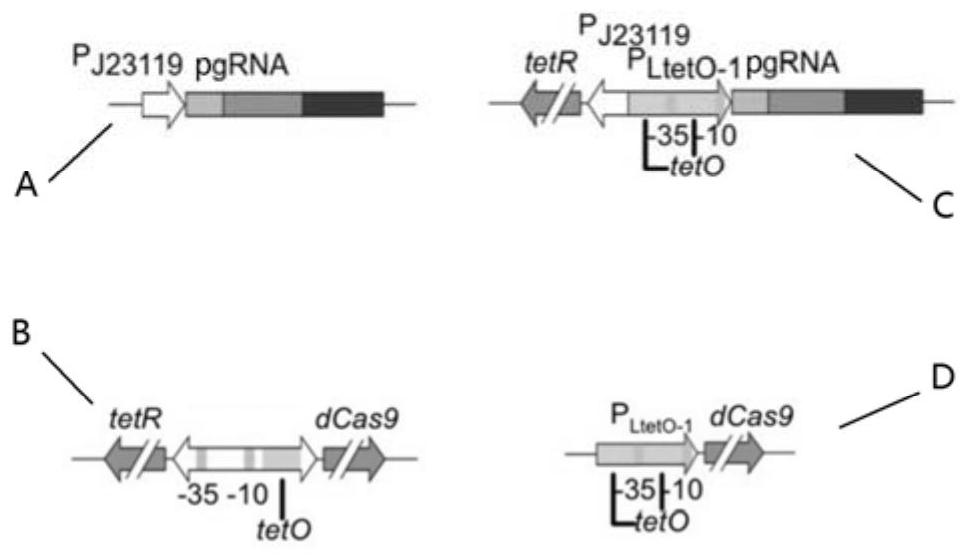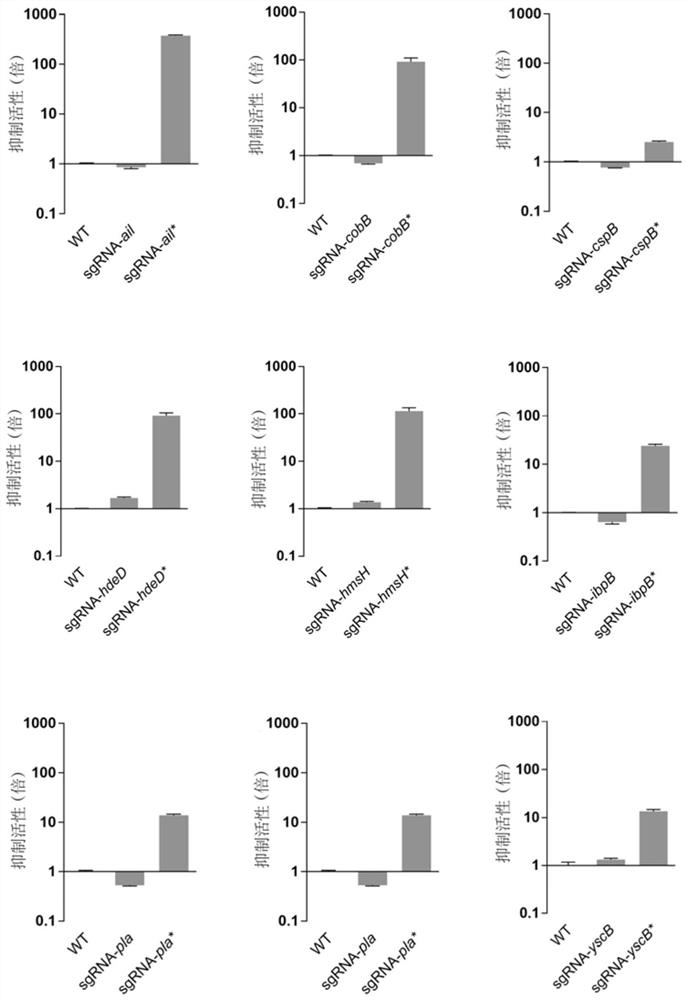Plasmid for crispri system, method for its construction and application in targeted gene silencing of Yersinia pestis
A gene and purpose technology, applied in the application of gene-directed silencing, the plasmid field of CRISPRi system, can solve the problems of complex operation and low efficiency, and achieve the effect of reducing transcription level and protein level
- Summary
- Abstract
- Description
- Claims
- Application Information
AI Technical Summary
Problems solved by technology
Method used
Image
Examples
Embodiment 1
[0044] Example 1: sgRNA expression plasmid and pdCas9-tetO plasmid
[0045] 1.1. Construction of plasmid pgRNA-phoP: The pgRNA vector (empty vector, its schematic structure is shown in 1A, obtained from Addgene#44251, website: https: / / www.addgene.org / ) as the template, using the following table 1 The primers phop-1o-F (SEQ ID NO: 21) and phop-1o-R (SEQ ID NO: 22) shown in Table 2 were applied to the pgRNA vector according to the system shown in Table 2 and the PCR program shown in Table 3 below. Carry out PCR amplification to obtain PCR amplification fragments, and then use restriction nucleases Spe I and HindIII to digest the pgRNA vector and its PCR amplification fragments respectively according to the restriction nucleases Spe I and HindIII according to the following table 4. The ligation system shown in Table 5 below connects the two restriction fragments to obtain an sgRNA expression plasmid (control plasmid) for the target gene phoP of Yersinia pestis, named plasmid pg...
Embodiment 2
[0086] Example 2: Use of Inducing Agents
[0087] 2.1. The inventors selected 9 genes (ail, cobB, cspB, hdeD, hmsH, ibpB, pla, slyA, yscB, each of which are related to the Yersinia pestis phenotype on the chromosome or plasmid in Yersinia pestis). The function of the gene is shown in Table 10 above), and the sgRNA expression plasmid constructed in Example 1 (see Table 10) and the dCas9-tetO plasmid are transformed into bacteria by electric shock to construct the corresponding target gene silencing strain, and use 1 μg / ml of aTc was used as the inducer, and the constructed silent strains were divided into silent strains under induced conditions (the inducer was added at the time of transformation) and silent strains under non-induced conditions. Meanwhile, wild control strains were set up. Each strain was grown to mid-log phase, or OD 620 is around 1.0.
[0088] Using the nucleotide sequences shown in Table 12 above, the qRT-PCR (real-time fluorescence quantitative PCR) exp...
Embodiment 3
[0092] Example 3: Protein Level Expression
[0093] The inventors selected 4 target genes hmsH, phoP, pla, slyA of Yersinia pestis (the respective gene functions are shown in Table 10 above), using the dual plasmid system corresponding to the target gene constructed in Example 1, transformed into the plague by electric shock The corresponding target gene silencing strain was constructed, and the induction culture was performed under non-inducing conditions and inducing conditions with 1 μg / ml aTc as the inducer (the inducer was added at the time of transformation), and the wild strain of Yersinia pestis was established at the same time. As a control, each strain tested was grown to mid-log phase, or OD 620 is around 1.0. Western blotting was used to verify the protein level changes of the target gene in the wild strain and the corresponding silenced strain, and the GroEL protein was used as the internal reference to keep the same amount of samples. The result is as Figur...
PUM
 Login to View More
Login to View More Abstract
Description
Claims
Application Information
 Login to View More
Login to View More - R&D
- Intellectual Property
- Life Sciences
- Materials
- Tech Scout
- Unparalleled Data Quality
- Higher Quality Content
- 60% Fewer Hallucinations
Browse by: Latest US Patents, China's latest patents, Technical Efficacy Thesaurus, Application Domain, Technology Topic, Popular Technical Reports.
© 2025 PatSnap. All rights reserved.Legal|Privacy policy|Modern Slavery Act Transparency Statement|Sitemap|About US| Contact US: help@patsnap.com



